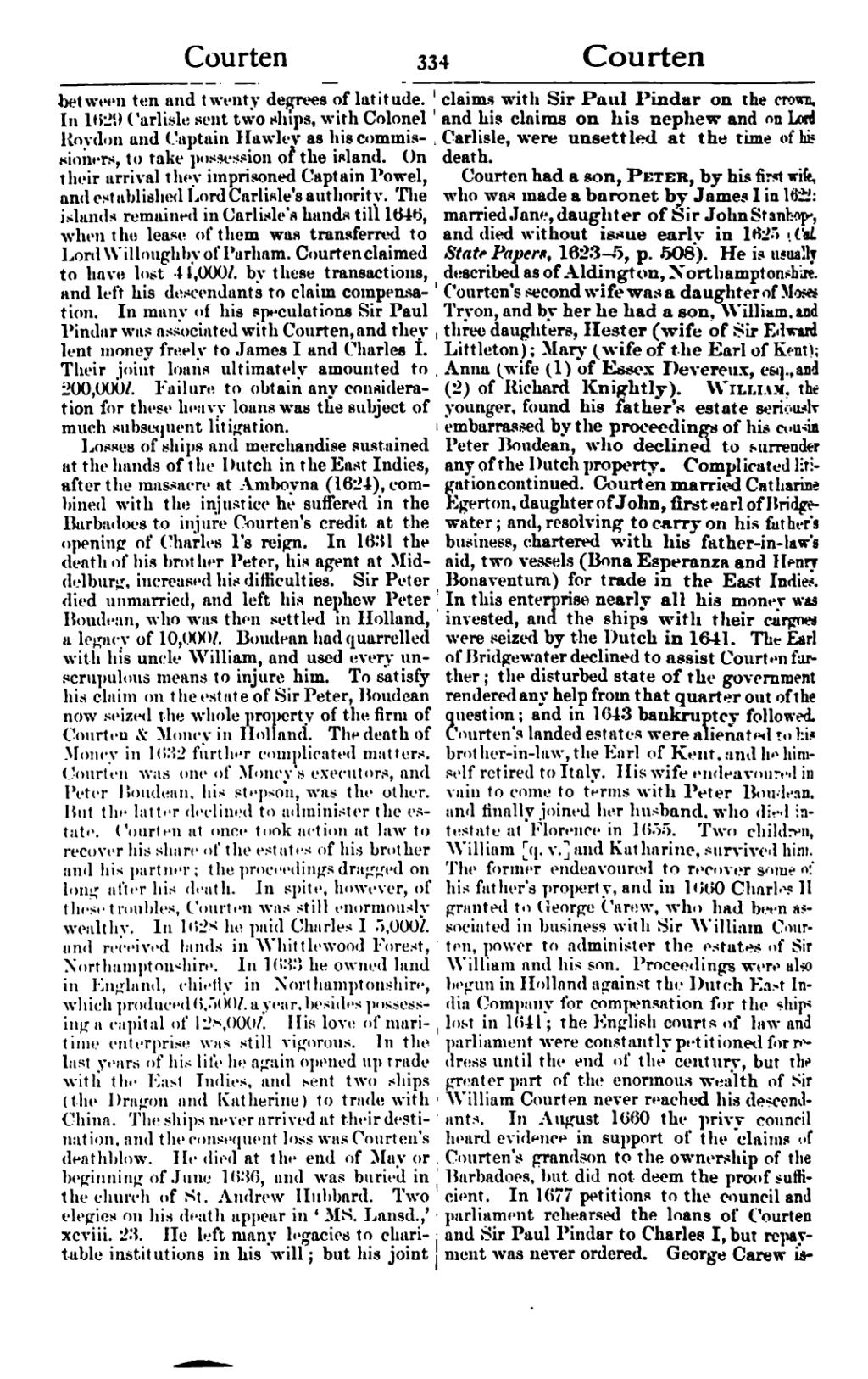between ten and twenty degrees of latitude. In 1629 Carlisle sent two ships, with Colonel Roydon and Captain Hawley as his commissioners, to take possession of the island. On their arrival they imprisoned Captain Powel, and established Lord Carlisle's authority. The islands remained in Carlisle's hands till 1646, when the lease of them was transferred to Lord Willoughby of Parham. Courten claimed to have lost 44,000l. by these transactions, and left his descendants to claim compensation. In many of his speculations Sir Paul Pindar was associated with Courten, and they lent money freely to James I and Charles I. Their joint loans ultimately amounted to 200,000l. Failure to obtain any consideration for these heavy loans was the subject of much subsequent litigation.
Losses of ships and merchandise sustained at the hands of the Dutch in the East Indies, after the massacre at Amboyna (1624), combined with the injustice he suffered in the Barbadoes to injure Courten's credit at the opening of Charles I's reign. In 1631 the death of his brother Peter, his agent at Middelburg, increased his difficulties. Sir Peter died unmarried, and left his nephew Peter Boudean, who was then settled in Holland, a legacy of 10,000l. Boudean had quarrelled with his uncle William, and used every unscrupulous means to injure him. To satisfy his claim on the estate of Sir Peter, Boudean now seized the whole property of the firm of Courten & Moncy in Holland. The death of Moncy in 1632 further complicated matters. Courten was one of Moncy's executors, and Peter Boudean, his stepson, was the other. But the latter declined to administer the estate. Courten at once took action at law to recover his share of the estates of his brother and his partner; the proceedings dragged on long after his death. In spite, however, of these troubles, Courten was still enormously wealthy. In 1628 he paid Charles I 5,000l. and received lands in Whittlewood Forest, Northamptonshire. In 1633 he owned land in England, chiefly in Northamptonshire, which produced 6,500l. a year, besides possessing a capital of 128,000l. His love of maritime enterprise was still vigorous. In the last years of his life he again opened up trade with the East Indies, and sent two ships (the Dragon and Katherine) to trade with China. The ships never arrived at their destination, and the consequent loss was Courten's deathblow. He died at the end of May or beginning of June 1636, and was buried in the church of St. Andrew Hubbard. Two elegies on his death appear in ‘MS. Lansd.,’ xcviii. 23. He left many legacies to charitable institutions in his will; but his joint claims with Sir Paul Pindar on the crown, and his claims on his nephew and on Lord Carlisle, were unsettled at the time of his death.
Courten had a son, Peter, by his first wife, who was made a baronet by James I in 1622; married Jane, daughter of Sir John Stanhope, and died without issue early in 1625 (Cal. State Papers, 1623–5, p. 508). He is usually described as of Aldington, Northamptonshire. Courten's second wife was a daughter of Moses Tryon, and by her he had a son, William, and three daughters, Hester (wife of Sir Edward Littleton); Mary (wife of the Earl of Kent); Anna (wife (1) of Essex Devereux, esq., and (2) of Richard Knightly). William, the younger, found his father's estate seriously embarrassed by the proceedings of his cousin Peter Boudean, who declined to surrender any of the Dutch property. Complicated litigation continued. Courten married Catharine Egerton, daughter of John, first earl of Bridgewater; and, resolving to carry on his father's business, chartered with his father-in-law's aid, two vessels (Bona Esperanza and Henry Bonaventura) for trade in the East Indies. In this enterprise nearly all his money was invested, and the ships with their cargoes were seized by the Dutch in 1641. The Earl of Bridgewater declined to assist Courten further; the disturbed state of the government rendered any help from that quarter out of the question; and in 1643 bankruptcy followed. Courten's landed estates were alienated to his brother-in-law, the Earl of Kent, and he himself retired to Italy. His wife endeavoured in vain to come to terms with Peter Boudean, and finally joined her husband, who died intestate at Florence in 1655. Two children, William [q. v.] and Katharine, survived him. The former endeavoured to recover some of his father's property, and in 1660 Charles II granted to George Carew, who had been associated in business with Sir William Courten, power to administer the estates of Sir William and his son. Proceedings were also begun in Holland against the Dutch East India Company for compensation for the ships lost in 1641; the English courts of law and parliament were constantly petitioned for redress until the end of the century, but the greater part of the enormous wealth of Sir William Courten never reached his descendants. In August 1660 the privy council heard evidence in support of the claims of Courten's grandson to the ownership of the Barbadoes, but did not deem the proof sufficient. In 1677 petitions to the council and parliament rehearsed the loans of Courten and Sir Paul Pindar to Charles I, but repayment was never ordered. George Carew is-
